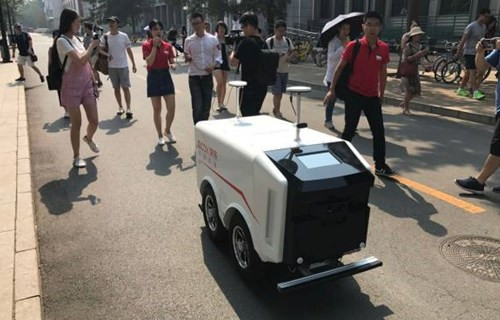
On June 18, students at six Chinese universities received items they had purchased from JD.com from robot couriers.
6月18日,中国6所大学的学生从机器人快递员手中拿到了从京东上购买的物品。
Still a pilot project, the robots were dispatched to just half a dozen universities, including Renmin University, Tsinghua University and Zhejiang University. At JD.com delivery stations, items were first divided among the robots according to size. The smart robots were then able to plan their routes with the help of an automatic navigation system, which also assists them in avoiding obstacles en route.
机器人快递员仍然是一个试点项目,只在包括人民大学、清华大学和浙江大学在内的6所大学。在京东配送站,物品首先会根据大小在机器人之间进行分配。随后,智能机器人就能够在自动导航系统的帮助下规划路线,同时该技术还能协助它们在送货途中避开障碍物。
They follow preset routes and send messages to the recipients when they are 100 meters away from their destinations. The robots can move as quickly as electric bikes, though they are set to walk at the speed of pedestrians when on campus. They also slow down in advance of speed bumps.
机器人会按照预先设定好的路线前进,在距离目的地100米时向收货人发送快递信息。尽管这些机器人被要求在校园里保持和行人一样的速度,但是它们的移动速度可以像电动自行车一样快。这些机器人也能够在减速带前减速。
University students will be the first group to benefit from the new technology. Considering the openness of college students when it comes to hi-tech products, JD.com will highlight its 1,300 delivery stations at universities as the promotional campaign for robot couriers kicks off.
大学生将是第一个受益于这项技术的群体。考虑到大学生群体对高科技产品的开放态度,为了促进机器人快递员项目,京东将在高校设立1300个配送站。

新年伊始,听说有好多同学声称自己去年的读书li...

不知是不是因为今年疫情的缘故,总觉得时间过得...

2020年即将过去,本年度的【好书荐读】系列也迎...
